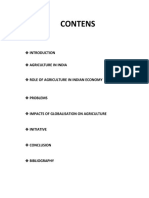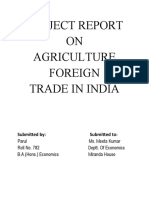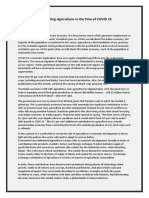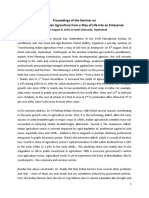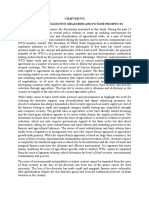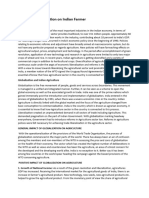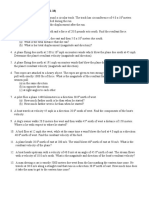Contribution of Agriculture To GNP, Its Role As A Source of Savings and Marketing and Manufacturing Goods
Contribution of Agriculture To GNP, Its Role As A Source of Savings and Marketing and Manufacturing Goods
Uploaded by
dilsharakaviCopyright:
Available Formats
Contribution of Agriculture To GNP, Its Role As A Source of Savings and Marketing and Manufacturing Goods
Contribution of Agriculture To GNP, Its Role As A Source of Savings and Marketing and Manufacturing Goods
Uploaded by
dilsharakaviOriginal Description:
Original Title
Copyright
Available Formats
Share this document
Did you find this document useful?
Is this content inappropriate?
Copyright:
Available Formats
Contribution of Agriculture To GNP, Its Role As A Source of Savings and Marketing and Manufacturing Goods
Contribution of Agriculture To GNP, Its Role As A Source of Savings and Marketing and Manufacturing Goods
Uploaded by
dilsharakaviCopyright:
Available Formats
CONTRIBUTION OF AGRICULTURE
TO GNP, ITS ROLE AS A SOURCE OF
SAVINGS AND MARKETING AND
MANUFACTURING GOODS
Presented By : Pamodi Edirisinghe
Presented To: Dr .Meera M
Contents
Introduction
Contribution of Agriculture to GNP
Recent Trends of Agriculture to GNP
Role played by Agriculture in Savings
Contribution of Agriculture in Marketing and Manufacturing Goods
Conclusion
Introduction
In many developing countries, agriculture provides employment to more than 66%
of the population and contributes nearly 27% to the GNP.
In most of the developed countries such as USA, England, Germany and Japan the
percentage of people engaged or employed in agriculture is 3%, 2%, 4% and 7 %
respectively. In the USA the share of agriculture in GNP is 3%, in England and
France the share of agriculture in GNP is 2% and 5 % respectively
Agriculture is the main occupation of most of the underdeveloped countries and
at the same time it is the most backward sector out of all
Thus Agriculture can be considered as the back bone of the country and the
economic system of India. Nearly 2/3 rd of people in India depends upon
agriculture directly or indirectly and 70 percent of this population lives in rural
areas. The role played by agriculture in the GNP can be discussed in various
dimensions.
1.Share in national Income
2.Share in Employment
3.Basis of Industrial Development
4.Importance in foreign trade
5.Importance in household consumption
6.Significance for trade and services
4
Recent Trends in Agriculture to GNP
300
250
200
150
259.23
100
137.17
162.62
141.77
139.39
FY 9
FY 10
157.35
160.8
FY 11
FY 12
140.77
132.71
FY 13
FY 14
50
0
FY 7
FY 8
FY 15
Some of the recent major government initiatives in
the sector are as follows:
India and Lithuania have agreed to intensify agricultural cooperation, especially in sectors
like food and dairy processing.
Gujarat Government has planned to connect 26 Agricultural Produce Market Committees
(APMCs) via electronic market platform, under the National Agriculture Market (NAM)
initiative.
The State Government of Telangana plans to spend Rs 81,000 crore (US$ 12.1 billion) over
the next three years to complete ongoing irrigation projects and also undertake two new
projects for lifting water from the Godavari and Krishna river.
The National Dairy Development Board (NDDB) announced 42 dairy projects with a
financial outlay of Rs 221 crore (US$ 34.02 million) to boost milk output and increase per
6
animal production of milk.
The government planned to invest Rs 50,000 crore (US$ 7.7 billion) to revive four
fertilizer plants and set up two plants to produce farm nutrients.
The Ministry of Food Processing Industries took some new initiatives to develop the foodprocessing sector that would enhance the income of farmers and export of agro and
processed foods, among others.
The Government of Telangana allocated Rs 4,250 crore (US$ 654 million) for the first
phase of the farm loan waiver scheme. The scheme is expected to benefit 3.6 million
farmers who took loans of Rs 100,000 (~US$ 1,539) or below before March 31, 2014.
7
Agriculture as a source of Savings
Contribution to National Income
Supply of Wage Goods
Increase in Employment
Agricultural Industrial development
Agriculture and Foreign Trade
Role Played in Internal Trade
Capital Formation
8
Role of agriculture in marketing and
manufacturing of goods.
Agricultural marketing is mainly the buying and selling of agricultural products.
The task of distribution system is to match the supply with the existing demand by whole selling
and retailing in various points of different markets like primary, secondary or terminal markets.
Most of the agricultural products in India are sold by farmers in the private sector to moneylenders
(to whom the farmer may be indebted) or to village traders.
There are many reasons for the bulk of produce being sold by the farmer in the village.
The farming units are small and most of the farmers do not have the transportation facilities.
Road development is not quite adequate.
9
Agricultural Marketing
10
Agricultural goods that are manufactured are different from industrial goods
Most of the agricultural products are perishable in nature
Farm products are produced on a particular season and they cannot be produced whole
through the year
similarly most of the agricultural goods are produced in bulks therefore storage facilities
and transportation is difficult and at the same time expensive.
With the globalization agricultural production and marketing of commodities have become
competitive
11
Trends in Agricultural Production
1.Agricultural Production and productivity
12
2.Diversification of Agriculture
13
3.Modernization of Agriculture
With the start of the Green revolution, modern technology, improvement of
irrigation facilities took place. It also introduces the use of High yielding
variety of seeds and use of chemical fertilizers, pesticides which are
produced outside the agricultural sector.
With the intervention of new technology instead of single crop, two or
three crops could be able to grow with the increasing agricultural output.
Thus most of the farmers in Punjab, Haryana, Andhra Pradesh and Uttar
Pradesh majority of farmers shifted in to the intensive cultivation.
14
4.Improvement of the agrarian system :
Central Government has enacted a number of laws regarding the land reforms.
The laws were mainly implemented to abolish the Zamindari system, land ceiling
and the tenancy reforms. The government succeeded in abolishing the
Zamindari.
This created a considerable rate of improvement in the lives of the farmers.
Rents came down and the concept of land to the tiller became strong.
The land ceiling was not effective even though there was redistribution of land,
to the beneficiaries. The land reforms were successful in West Bengal and in
Kerala more than in other districts
15
5) Cooperate Entry to Agriculture
Co operations know that agriculture is not an area which is not tapped fully. With the entry of
the co operations the farmers have lot of reasons to be happy.
Many cooperation such as Reliance, ITC ,Trinethra and others are making a beeline for the
doorstep of the farmers to buy there products. During the earlier days it was the farmers who
took their produced to the market and searched for channels of marketing .
Giving entry to the cooperates can be a best solution to outrun the problems that can be seen
in the sector, by ensuring proper prices for the farmers for the products they have produced.
Several experts comments that cooperate farming could be a possible solution for the crisis in
which that is being faced by the agricultural sector, because they are capable of undertaking
the risk and face financial losses more easily than small and medium farmers.
16
Conclusion
When considering all the above factors it is quite evident agriculture plays a significant
role in the GNP of India. Apart from that it also provides evidence that how Agriculture
can contribute to mobilize savings within the country, through expanding and
diversifying its production processes. It also indicates how agriculture is playing a
significant role in the process of production of goods and marketing .
Finally it also gives us a glimpse of how the agricultural production has changed
overtime and its modern trends, highlighting the importance of the sector as a major
sector of economic development of the country.
17
References
Emmanuel.M ;( 2012) Basics of Business and Management (Second Edition); Pearson
Education South Asia.
Dr.Tyagi V; Indias Agriculture : ( 2012); Challenges for Growth and Development in present
scenario; International Journal; Volume 2; Issue 1.
TNAU Agricultural Portal; Agricultural Marketing And Agri Business;
http://agritech.tnau.ac.in/agricultural_marketing/agrimark_India.html
https://www.indiaagronet.com/indiaagronet/Agri_marketing/contents/Concept.htm
http://www.hillagric.ac.in/edu/coa/AgriEcoExtEduRSocio/lectures/AgEcon244.PDF
18
19
You might also like
- OSCE Common Drugs To Explain (Oscestop) - UnlockedDocument2 pagesOSCE Common Drugs To Explain (Oscestop) - Unlockedhannahkim55No ratings yet
- Importance of Agribusiness in Indian EconomyDocument18 pagesImportance of Agribusiness in Indian EconomyAmanjit Kaur -SOBS50% (6)
- 1 Importance of AgricultureDocument12 pages1 Importance of AgricultureAnuragNo ratings yet
- Isotopes AnswersDocument2 pagesIsotopes AnswersdilsharakaviNo ratings yet
- III. Importance of AgricultureDocument10 pagesIII. Importance of AgricultureAnanya sahuNo ratings yet
- Project Report On The Revival of Indian AgricultureDocument79 pagesProject Report On The Revival of Indian Agricultureabhineet kumar singh100% (3)
- Humanities - Ii (Hsmc-301) : Asansol Engineering CollegeDocument6 pagesHumanities - Ii (Hsmc-301) : Asansol Engineering Collegevardhanaditya04.aecNo ratings yet
- Importance of Agriculture MarketingDocument3 pagesImportance of Agriculture MarketingShuvojeet MandalNo ratings yet
- Mini ProjectDocument9 pagesMini ProjectlakunarasimharaoNo ratings yet
- 115 - Baec 13B - 2020120502010511Document24 pages115 - Baec 13B - 2020120502010511Deeksha SharmaNo ratings yet
- Indian Agriculture SectorDocument5 pagesIndian Agriculture SectorNikhil JainNo ratings yet
- Argirculture in IndiaDocument32 pagesArgirculture in Indiababu rs100% (1)
- AGRICULTUREDocument32 pagesAGRICULTUREbabu rsNo ratings yet
- DFI Vol-12ADocument213 pagesDFI Vol-12ADanish NehalNo ratings yet
- FertilizerDocument80 pagesFertilizerJanki PatelNo ratings yet
- 2nd LectureDocument3 pages2nd LectureTaushif AhammedNo ratings yet
- Grade 7 Agriculture Science Week 2 Lesson 1Document15 pagesGrade 7 Agriculture Science Week 2 Lesson 1matthewmenzies592No ratings yet
- Agriculture Ies Unit 5Document71 pagesAgriculture Ies Unit 5Rajesh GargNo ratings yet
- Agricultural Economics Thesis Topics in IndiaDocument4 pagesAgricultural Economics Thesis Topics in IndiaMaria Perkins100% (2)
- Innovative Policy Interventions For Transformation of Farm SectorDocument17 pagesInnovative Policy Interventions For Transformation of Farm SectorAjayNo ratings yet
- DFI Volume 4Document273 pagesDFI Volume 4Parshuram911No ratings yet
- REPORTDocument17 pagesREPORTRishabh AhujaNo ratings yet
- Project Report ON Agriculture Foreign Trade in India: Submitted By: Submitted ToDocument18 pagesProject Report ON Agriculture Foreign Trade in India: Submitted By: Submitted ToParul GirdharNo ratings yet
- DFI Volume 7Document187 pagesDFI Volume 7abhishek H M madegowdaNo ratings yet
- An Influence of Corporates On Farmers in IndiaDocument19 pagesAn Influence of Corporates On Farmers in IndiaJainsonNo ratings yet
- 1) Role of Agriculture in IndiaDocument10 pages1) Role of Agriculture in IndiagulhasnaNo ratings yet
- Contribution of Rural EconomyDocument18 pagesContribution of Rural EconomyAbdu Samad MNo ratings yet
- M1PPTDocument34 pagesM1PPTbarathkumar00001No ratings yet
- Will Indiabe Able To Double Farmer's Income in Next Five Years?Document9 pagesWill Indiabe Able To Double Farmer's Income in Next Five Years?DrAbhishek SarafNo ratings yet
- Project Report On Agriculture Foreign Trade in IndiaDocument17 pagesProject Report On Agriculture Foreign Trade in IndiarriittuuNo ratings yet
- SWOT Analysis of Indian AgricultureDocument8 pagesSWOT Analysis of Indian AgricultureManthan LalanNo ratings yet
- Rawe Report PratikshaDocument87 pagesRawe Report PratikshaPratiksha UghadeNo ratings yet
- Unit 1 Agriculture: StructureDocument23 pagesUnit 1 Agriculture: StructureAmlan MishraNo ratings yet
- Role of Technology in Economic DevelopmentDocument14 pagesRole of Technology in Economic DevelopmentArnavNo ratings yet
- Saurabh Dissertation On Ready To Eat FoodsDocument60 pagesSaurabh Dissertation On Ready To Eat FoodsSaurabh SinhaNo ratings yet
- Reinventing Agriculture in The Time of COVID 19Document2 pagesReinventing Agriculture in The Time of COVID 19Shaloo MinzNo ratings yet
- A Report On Improving Agriculture Performance Subject: Seminar On ContemporaryDocument26 pagesA Report On Improving Agriculture Performance Subject: Seminar On ContemporaryVeeral Shah100% (1)
- Agriculture-Industry Interface: Value Added Farm ProductsDocument9 pagesAgriculture-Industry Interface: Value Added Farm ProductsAnanda PreethiNo ratings yet
- Agri PDFDocument11 pagesAgri PDFHarini MudhapakaNo ratings yet
- The Agricultural Sector: ECO213: Indian EconomyDocument31 pagesThe Agricultural Sector: ECO213: Indian EconomySonam PeldenNo ratings yet
- Role of Agriculture in The Economic Development of A CountryDocument9 pagesRole of Agriculture in The Economic Development of A CountryJoey LagahitNo ratings yet
- Seminar ReportDocument6 pagesSeminar ReportBalasubramanian SankaranarayananNo ratings yet
- DFI Volume 1Document131 pagesDFI Volume 1shruthinNo ratings yet
- Indian Economy IntroductionDocument4 pagesIndian Economy IntroductionVaibhav BadgiNo ratings yet
- Economcssem 2Document6 pagesEconomcssem 2Kamran JaveedNo ratings yet
- BCGDocument138 pagesBCGANKUSHSINGH2690No ratings yet
- Indian Agriculture: SWOT AnalysisDocument12 pagesIndian Agriculture: SWOT Analysisdc2029100% (1)
- GEF Assisted Green - Ag ProjectDocument6 pagesGEF Assisted Green - Ag ProjectbabyNo ratings yet
- Objectives: Economic GrowthDocument10 pagesObjectives: Economic GrowthSOHEL BANGINo ratings yet
- Chapter-Vii Recapitulation, Suggestive Measurer and Future ProspectsDocument7 pagesChapter-Vii Recapitulation, Suggestive Measurer and Future ProspectsChandanNo ratings yet
- Rawe Report PratikshaDocument93 pagesRawe Report PratikshaPratiksha UghadeNo ratings yet
- Unit-3 Scope of AgricultureDocument6 pagesUnit-3 Scope of Agricultureagricultural lifeNo ratings yet
- 10) Agriculture in IndiaDocument48 pages10) Agriculture in Indiaj73774352No ratings yet
- Significance of Agriculture Sector in Rural Areas: Dr. Radhika KapurDocument15 pagesSignificance of Agriculture Sector in Rural Areas: Dr. Radhika KapurSaffa TariqNo ratings yet
- A Study On Development Trends of Food Processing Sector in India - Dr. Anoop Kumar Singh Vol-5-Issue-1Document7 pagesA Study On Development Trends of Food Processing Sector in India - Dr. Anoop Kumar Singh Vol-5-Issue-1Sravya DoppaniNo ratings yet
- Discuss The Impact of Agriculture On Industrial Development?Document33 pagesDiscuss The Impact of Agriculture On Industrial Development?San Deep SharmaNo ratings yet
- Impact of Globalization On Indian FarmerDocument3 pagesImpact of Globalization On Indian Farmers29053068No ratings yet
- Budget Analysis On Agriculture Sector of IndiaDocument10 pagesBudget Analysis On Agriculture Sector of Indiasuvreeng3No ratings yet
- Agriculture HomeworkDocument19 pagesAgriculture HomeworkSiya SunilNo ratings yet
- Role of Agriculture in Economic Development in IndiaDocument26 pagesRole of Agriculture in Economic Development in IndiaAnuj Jaiswal100% (2)
- Agriculture in India: Contemporary Challenges: in the Context of Doubling Farmer’s IncomeFrom EverandAgriculture in India: Contemporary Challenges: in the Context of Doubling Farmer’s IncomeNo ratings yet
- Learning with Fun, Agricultural Economics and Agri-BusinessFrom EverandLearning with Fun, Agricultural Economics and Agri-BusinessNo ratings yet
- Resolving Vectors WorksheetDocument1 pageResolving Vectors WorksheetdilsharakaviNo ratings yet
- Summary Notes - Topic 8 Astrophysics - Edexcel Physics IGCSEDocument3 pagesSummary Notes - Topic 8 Astrophysics - Edexcel Physics IGCSEdilsharakaviNo ratings yet
- Summary Notes - Topic 2 ElectricityDocument6 pagesSummary Notes - Topic 2 ElectricitydilsharakaviNo ratings yet
- Classification of StarsDocument4 pagesClassification of StarsdilsharakaviNo ratings yet
- Edexcel Physics IGCSE: Forces and MotionDocument8 pagesEdexcel Physics IGCSE: Forces and MotiondilsharakaviNo ratings yet
- Charge and Current: Current in A Circuit Is Defined As - This Means The Charge Flowing Past ADocument5 pagesCharge and Current: Current in A Circuit Is Defined As - This Means The Charge Flowing Past AdilsharakaviNo ratings yet
- 3.13 - Vectors WorksheetDocument2 pages3.13 - Vectors Worksheetdilsharakavi100% (1)
- Uniform Circular Motion: Name: - Date: - Period: - WorksheetDocument2 pagesUniform Circular Motion: Name: - Date: - Period: - WorksheetdilsharakaviNo ratings yet
- GCSE 32B SoundDocument33 pagesGCSE 32B SounddilsharakaviNo ratings yet
- WavesDocument11 pagesWavesdilsharakaviNo ratings yet
- 3.2 Plant Classification WorksheetDocument3 pages3.2 Plant Classification WorksheetdilsharakaviNo ratings yet
- Horizontal Circular PracDocument3 pagesHorizontal Circular PracdilsharakaviNo ratings yet
- WPH13 01 Que 20190509 PDFDocument16 pagesWPH13 01 Que 20190509 PDFdilsharakaviNo ratings yet
- Energy KS3Document4 pagesEnergy KS3dilsharakaviNo ratings yet
- Different Forces Around You: Task 1: Air Resistance (Levels 4-5)Document2 pagesDifferent Forces Around You: Task 1: Air Resistance (Levels 4-5)dilsharakaviNo ratings yet
- Air Resistance: Task 1: Top Speeds (Levels 4-5) A B A BDocument2 pagesAir Resistance: Task 1: Top Speeds (Levels 4-5) A B A BdilsharakaviNo ratings yet
- 1) Discuss Which Is The Odd One Out and Why?Document3 pages1) Discuss Which Is The Odd One Out and Why?dilsharakaviNo ratings yet
- Fast and Slow Twitch Muscle ActivityDocument1 pageFast and Slow Twitch Muscle ActivitydilsharakaviNo ratings yet
- Moment of A Force Force X Distance From The PivotDocument1 pageMoment of A Force Force X Distance From The PivotdilsharakaviNo ratings yet
- 2.1.6 Work Done & PowerDocument10 pages2.1.6 Work Done & PowerdilsharakaviNo ratings yet
- A2 Biology Muscles Exam QuestionsDocument2 pagesA2 Biology Muscles Exam QuestionsdilsharakaviNo ratings yet
- TuberculosisDocument16 pagesTuberculosisdilsharakaviNo ratings yet
- Unit Test 1: Grow - Leaf - Chloroplasts - Roots - Upright - Wall - Water Support - Vacuole - LightDocument3 pagesUnit Test 1: Grow - Leaf - Chloroplasts - Roots - Upright - Wall - Water Support - Vacuole - LightdilsharakaviNo ratings yet
- Cisco ISE - MDM Partner Integration: Use CasesDocument2 pagesCisco ISE - MDM Partner Integration: Use CasesVarun KaushalNo ratings yet
- Water Pollution Grade5Document4 pagesWater Pollution Grade5Salma BazziNo ratings yet
- Construction Technology Chapter OneDocument20 pagesConstruction Technology Chapter OneLego EdrisaNo ratings yet
- Marine Surveying and Casualty Investigation Subject: Subject Code: 4409 Lecture-1 Bornali Rahman Lecturer Shipping and Maritime ScienceDocument14 pagesMarine Surveying and Casualty Investigation Subject: Subject Code: 4409 Lecture-1 Bornali Rahman Lecturer Shipping and Maritime ScienceIsmail Jabe UllahNo ratings yet
- Hydraulics AssignmentDocument24 pagesHydraulics AssignmentHaseeb JamalNo ratings yet
- 808 & 821 Champion SwivelsDocument5 pages808 & 821 Champion SwivelsComstar SupplyNo ratings yet
- HOMEof The AshfallDocument4 pagesHOMEof The AshfallJohn John EstiponaNo ratings yet
- Ahmad Ruslan Mohd RidzuanDocument5 pagesAhmad Ruslan Mohd RidzuanaminNo ratings yet
- Licensing Brief PLT Licensing Microsoft Server Products For Use in Virtual Environments Oct2022Document14 pagesLicensing Brief PLT Licensing Microsoft Server Products For Use in Virtual Environments Oct2022David GonzalezNo ratings yet
- NSTP 1 Syllabus by Jeiar BurgosDocument9 pagesNSTP 1 Syllabus by Jeiar BurgosJoanna Rose BurgosNo ratings yet
- 1 s2.0 S0142941822003245 MainDocument8 pages1 s2.0 S0142941822003245 Mainestefanny silveraNo ratings yet
- Ultimate ADHD Guide To A Healtheir You DownloadDocument6 pagesUltimate ADHD Guide To A Healtheir You DownloadCPsych Ayesha MehmoodNo ratings yet
- Silo - Tips Oracle 11g r2 Grid Infrastructure Installation On 2 Node Cluster Using VirtualboxDocument29 pagesSilo - Tips Oracle 11g r2 Grid Infrastructure Installation On 2 Node Cluster Using VirtualboxTAHA KANNANENo ratings yet
- CDI4 LESSON 12 Traffic Law EnforcementDocument31 pagesCDI4 LESSON 12 Traffic Law EnforcementKuya Khy100% (1)
- RR207Document48 pagesRR207vttrlcNo ratings yet
- Diphthong Marking in Persian Abjad - Persian Grammar - Free Online LessonsDocument3 pagesDiphthong Marking in Persian Abjad - Persian Grammar - Free Online Lessonsdak toNo ratings yet
- IGC Document 147-13-E Revision of Doc 147-08-EDocument75 pagesIGC Document 147-13-E Revision of Doc 147-08-Elutfirashid87No ratings yet
- Newsletter 12th - 18th August 2023Document33 pagesNewsletter 12th - 18th August 2023ashsjkakNo ratings yet
- Devoir de Contrôle N°2 - Anglais - 7ème (2020-2021) Mme Sarah BaatourDocument4 pagesDevoir de Contrôle N°2 - Anglais - 7ème (2020-2021) Mme Sarah BaatourMarwa ChaiebNo ratings yet
- Machine Learning and Artificial Intelligence: PG Diploma inDocument23 pagesMachine Learning and Artificial Intelligence: PG Diploma inAgent ShawNo ratings yet
- CHAPTER 10.5-Distance Time Graphs2Document13 pagesCHAPTER 10.5-Distance Time Graphs2Shweta BharrgavNo ratings yet
- Globl Exchange of Resources FinalDocument20 pagesGlobl Exchange of Resources Finaljaishree jain67% (3)
- Particle DynamicsDocument28 pagesParticle DynamicsKshithij R KikkeriNo ratings yet
- TSHR 6000 User Manual V1.3Document122 pagesTSHR 6000 User Manual V1.3pramodyad5810No ratings yet
- The History of North America, VOL 4: The Colonization of The Middle States and Maryland (1904) Fredrick R. JonesDocument616 pagesThe History of North America, VOL 4: The Colonization of The Middle States and Maryland (1904) Fredrick R. JonesWaterwind100% (1)
- Notes Ie Labour Laws and Their ReformDocument14 pagesNotes Ie Labour Laws and Their ReformBakul NegiNo ratings yet
- 13 Bearings, Seals & Transmission Products-V1Document28 pages13 Bearings, Seals & Transmission Products-V1Michael BeroberoNo ratings yet
- Ce Orientation Part 3 PDFDocument15 pagesCe Orientation Part 3 PDFFrancis Ko Badongen-Cawi Tabaniag Jr.0% (2)












